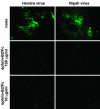Ephrin-B2 ligand is a functional receptor for Hendra virus and Nipah virus
- PMID: 15998730
- PMCID: PMC1169237
- DOI: 10.1073/pnas.0504887102
Ephrin-B2 ligand is a functional receptor for Hendra virus and Nipah virus
Abstract
Hendra virus (HeV) and Nipah virus (NiV) belong to the genus Henipavirus of the family Paramyxoviridae and are unique in that they exhibit a broad species tropism and cause fatal disease in both animals and humans. They infect cells through a pH-independent membrane fusion process mediated by their fusion and attachment glycoproteins. Previously, we demonstrated identical cell fusion tropisms for HeV and NiV and the protease-sensitive nature of their unknown cell receptor and identified a human cell line (HeLa-USU) that was nonpermissive for fusion and virus infection. Here, a microarray analysis was performed on the HeLa-USU cells, permissive HeLa-CCL2 cells, and two other permissive human cell lines. From this analysis, we identified a list of genes encoding known and predicted plasma membrane surface-expressed proteins that were highly expressed in all permissive cells and absent from the HeLa-USU cells and rank-ordered them based on their relative levels. Available expression vectors containing the first 10 genes were obtained and individually transfected into HeLa-USU cells. One clone, encoding human ephrin-B2 (EFNB2), was found capable of rendering HeLa-USU cells permissive for HeV- and NiV-mediated cell fusion as well as infection by live virus. A soluble recombinant EFNB2 could potently block fusion and infection and bind soluble recombinant HeV and NiV attachment glycoproteins with high affinity. Together, these data indicate that EFNB2 serves as a functional receptor for both HeV and NiV. The highly conserved nature of EFNB2 in humans and animals is consistent with the broad tropism exhibited by these emerging zoonotic viruses.
Figures





References
-
- Eaton, B. T. (2001) Microbes Infect. 3, 277-278. - PubMed
-
- Chua, K. B. (2003) J. Clin. Virol. 26, 265-275. - PubMed
-
- Tan, C. T. & Wong, K. T. (2003) Ann. Acad. Med. Singapore 32, 112-117. - PubMed
-
- Anonymous (2005) Commun. Dis. Rep. Wkly. 15, 6.
-
- Anonymous (2004) ProMed-mail, the International Society for Infectious Disease (December 14, 2004, archive no. 20041214.3307). Available at www.promedmail.org. Accessed December 17, 2004.
Publication types
MeSH terms
Substances
Grants and funding
LinkOut - more resources
Full Text Sources
Other Literature Sources
Molecular Biology Databases

